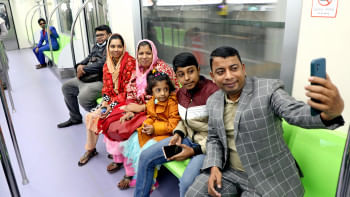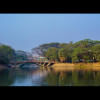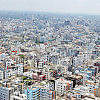How we should design the next generation of parks

The other day I went to visit several urban parks in both north and south Dhaka. These parks represented what I would call the first generation of designed urban parks in the city, upgraded between 1990 and 2020. The Dhanmondi Lake Park, Bahadur Shah Park, and Justice Shahabuddin Park are among them. These parks, in many ways, showcased design choices that both reflected and supported the country's neoliberal economic growth since the early 1990s. From cafes to new construction materials, the market economy was allowed to play an important role in the ways the upgraded parks were conceived as public places.
But first things first. What are the key characteristics of these parks? First, they provide some basic urban services like walkways, benches, shades for sitting, and public toilets, while also raising public awareness about the need to preserve city parks. Second, these parks feature non-essential spaces like large, paved areas for public gathering and exercise, stepped areas for sitting and performance or amphitheatres along the water, sports areas, elevated pedestrian promenades and bridges, water fountains, etc. Third, the parks include commercial establishments like cafes, restaurants, and juice bars, reportedly for generating funds for their maintenance and upkeep. Fourth, the parks become places of entertainment and revelry, attracting people from far-flung areas of the metropolis and, thereby, transforming them from a neighbourhood scale to a city scale.
In the past three decades, these parks have served to expand the city's public sphere, altering the nature of neighbourhoods and their urban characters. At the Dhanmondi Lake Park, I have talked to people who came from Old Dhaka or Tongi to have food in some of its waterside restaurants. People came from Mohammadpur and Uttara, among other places, to meet friends in a café at the Justice Shahabuddin Park in Gulshan. The scale and the intended users of the park raise a vexing question about the political economy of urban development.
Dhaka, which used to be a city of mosques, is now a city of restaurants, creating an unhelpful impression that we are a nation of insatiable hunger. We don't need another restaurant or cafe in our parks. We have them aplenty on our streets and in our marketplaces.
The first-generation upgraded parks are no longer neighbourhood concepts, a phenomenon that sometimes tends to alienate local residents. They are more like multipurpose public spaces, where people come to walk, exercise, jog, bike, meet friends, date, play sports, sweeten their mouth with a cafe latte, browse books, take selfies, sing songs, and revel. All this is fun, particularly in a city beleaguered by a zillion pathologies like air and noise pollution, excessive heat, and manusher gadagadi. Yet, the mood of these parks is predominantly that of entertainment and pleasure – hoi hullor, furti, addabaji, khaoa daoa – not necessarily one of feeling harmony with nature, although there are exceptions.
With their tendency to cram too many structures and impervious pavements, the parks feel claustrophobic. In the ones with tall fences, people even feel caged. Shahid Dr Fazle Rabbi Park's super tall glass fence could not be a more haunting symbol of a heat-island city. From the air, Bahadur Shah Park looks like an ecological oasis amid Old Dhaka. But once you approach it as a pedestrian, a boisterous café drowns out the park's intriguing colonial history and overwhelms its character of a natural sanctuary.
Time has come to shift gears in our park design approaches. We need "Park Design 2.0" for Bangladesh. The overbuilt character of Dhaka parks is a solemn reminder for us to reclaim them as the last fortress of city green. Do we need the 24/7 hustle and bustle of Dhaka – the cacophonous dramas of this sleepless city – reproduced in its parks too? Shouldn't the parks be our last refuge to be in and with nature, to hear birds chirp and winds blow, and to learn the names of trees and breathe their aromas? With the alarming disappearance of green from our cities and daily felling of urban trees, we – design professionals, policymakers, and local government administrators – need to demonstrate an unwavering commitment to understanding urban parks as nature, as green lungs, and as places to find solitude and de-stress. We need to protect our parks from false development and discriminatory gentrification. We need to save them from the tyranny of unnecessary concrete pavements, steel canopies, and restaurants.
The myth of "maintenance from earnings" as the basis of park upkeep should be questioned. There is no research, nor proof, that shows that the rent and profit from park restaurants and other commercial establishments are reinvested in park maintenance and improvement.
We need to preserve the organic conditions of our parks, rather than seeing them as opportunities for gifting business to cronies, securing inflated design consultancy fees, and playfields for using new building materials. Dhaka, which used to be a city of mosques, is now a city of restaurants, creating an unhelpful impression that we are a nation of insatiable hunger. We don't need another restaurant or cafe in our parks. We have them aplenty on our streets and in our marketplaces.
In fact, given the vast social and economic asymmetries of Dhaka and other cities, placing a restaurant or a café – selling pricey food and coffee – in the public park would be a form of social injustice. These restaurants in a public park create an exclusionary culture of passive discrimination: if you can't afford a Tk 400 coffee, you don't fit in here. Given the lack of greenery and quiet spaces in our cities, our parks should be where people are able to walk, run, forest-bathe, and be class-free, not be sedentary in expensive cafe chairs. There are cafes in the parks of New York City or Paris. But these cities also feature 100 percent natural green parks.
The myth of "maintenance from earnings" as the basis of park upkeep should be questioned. There is no research, nor proof, that shows that the rent and profit from park restaurants and other commercial establishments are reinvested in park maintenance and improvement.
Instead of the highly commercialising model of income generating businesses, we should consider community-based maintenance of parks. Such a model creates a strong participatory culture of local engagement and ownership – one of the central mantras of sustainable urbanism today. In exchange for a healthy, safe, and accessible park in their midst, local people are willing to pay a small monthly fee to create a co-management partnership to maintain and upgrade the park. This is the model we should institute for our parks' maintenance.
Instead of creating over-built spaces to meet the consumerist appetite of our rising urban middle class, the next generation of parks in Bangladeshi cities should inspire people to be citizen ecologists in a country that is environmentally vulnerable. We need more trees, not more restaurants, just as we need more footpaths, not more flyovers. This may sound like a simple statement, but it could be an effective development philosophy. Fifty-two years after independence, we should feel confident not to fall into the trap of generic development that doesn't speak to our ecological worldview.
Dr Adnan Zillur Morshed is an architect, architectural historian, urbanist, and professor. He teaches at the Catholic University of American in Washington, DC, and serves as executive director at the Centre for Inclusive Architecture and Urbanism in Brac University. His recent book is 'Dhaka Delirium.'

 For all latest news, follow The Daily Star's Google News channel.
For all latest news, follow The Daily Star's Google News channel. 











Comments